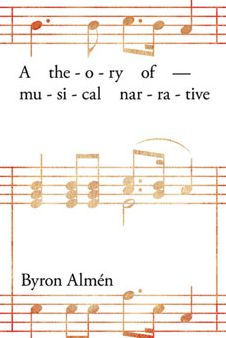
- ISBN-10:
- 025335238X
- ISBN-13:
- 9780253352385
- Pub. Date:
- 11/26/2008
- Publisher:
- Indiana University Press
- ISBN-10:
- 025335238X
- ISBN-13:
- 9780253352385
- Pub. Date:
- 11/26/2008
- Publisher:
- Indiana University Press

Buy New
$39.95Buy Used
$31.07-
-
SHIP THIS ITEM
Temporarily Out of Stock Online
Please check back later for updated availability.
-
Overview

Product Details
| ISBN-13: | 9780253352385 |
|---|---|
| Publisher: | Indiana University Press |
| Publication date: | 11/26/2008 |
| Series: | Musical Meaning and Interpretation |
| Pages: | 264 |
| Product dimensions: | 6.30(w) x 9.50(h) x 1.00(d) |
| Age Range: | 216 - 3 Months |
About the Author
Table of Contents
ContentsPrefaceAcknowledgmentsPart 1. A Theory of Musical Narrative1. An Introduction to Narrative Analysis: Chopin's Prelude in G Major, Op. 28, No. 32. Perspectives and Critiques3. A Theory of Musical Narrative: Conceptual Considerations4. A Theory of Musical Narrative: Analytical Considerations5. Narrative and TopicPart 2. Archetypal Narratives and Phases6. Romance Narratives and Micznik's Degrees of Narrativity7. Tragic Narratives: An Extended Analysis of Schubert, Piano Sonata in B-flat Major, D. 960, First Movement8. Ironic Narratives: Subtypes and Phases9. Comic Narratives and Discursive Strategies10. Summary and ConclusionGlossaryNotesBibliographyIndexWhat People are Saying About This
"Reimagining literary narrative theory in musical terms, Almén (Univ. of Texas, Austin) has appropriated, explicitly, various constructs and methods, albeit with qualification. The endeavor is informed by semiotic and topic theories—The Semiotics of Music, ed. by Eero Tarasti (1987), was a progenitor. That the outcome seems so natural, elegant, and convincing testifies to the author's careful work and deep understanding. He asserts that the book does not provide an analytic method but, rather, a framework; several analyses, large and small, will serve as a primer for others. In the first part of the book, Almén explains the theoretical underpinning; in the second part, he introduces four narrative archetypes that correspond precisely to the four mythoi Northrop Frye gave in his essay 'Archetypal Criticism' (Anatomy of Criticism, 1957). It would seem that Almén's theory can be applied as a means of understanding any musical work, regardless of type or style or purpose. Might a fundamental connectedness of seemingly disparate musics be revealed? That would be something. The book is out of range for all but the most intrepid undergraduates, but it is a must for all music theory collections. Summing Up: Essential. Upper-division undergraduates through researchers and faculty. —Choice"
Reimagining literary narrative theory in musical terms, Almén (Univ. of Texas, Austin) has appropriated, explicitly, various constructs and methods, albeit with qualification. The endeavor is informed by semiotic and topic theories—The Semiotics of Music, ed. by Eero Tarasti (1987), was a progenitor. That the outcome seems so natural, elegant, and convincing testifies to the author's careful work and deep understanding. He asserts that the book does not provide an analytic method but, rather, a framework; several analyses, large and small, will serve as a primer for others. In the first part of the book, Almén explains the theoretical underpinning; in the second part, he introduces four narrative archetypes that correspond precisely to the four mythoi Northrop Frye gave in his essay 'Archetypal Criticism' (Anatomy of Criticism, 1957). It would seem that Almén's theory can be applied as a means of understanding any musical work, regardless of type or style or purpose. Might a fundamental connectedness of seemingly disparate musics be revealed? That would be something. The book is out of range for all but the most intrepid undergraduates, but it is a must for all music theory collections. Summing Up: Essential. Upper-division undergraduates through researchers and faculty. —Choice
Almén's work is far reaching both for music theory and musicology and will make a substantial and timely contribution to the study of musical narrative.
In this pathbreaking study, Byron Almén convincingly demonstrates that a piece of music can convey a narrative that is intrinsically musical, not added by a program or text.
Reimagining literary narrative theory in musical terms, Almén (Univ. of Texas, Austin) has appropriated, explicitly, various constructs and methods, albeit with qualification. The endeavor is informed by semiotic and topic theories—The Semiotics of Music, ed. by Eero Tarasti (1987), was a progenitor. That the outcome seems so natural, elegant, and convincing testifies to the author's careful work and deep understanding. He asserts that the book does not provide an analytic method but, rather, a framework; several analyses, large and small, will serve as a primer for others. In the first part of the book, Almén explains the theoretical underpinning; in the second part, he introduces four narrative archetypes that correspond precisely to the four mythoi Northrop Frye gave in his essay 'Archetypal Criticism' (Anatomy of Criticism, 1957). It would seem that Almén's theory can be applied as a means of understanding any musical work, regardless of type or style or purpose. Might a fundamental connectedness of seemingly disparate musics be revealed? That would be something. The book is out of range for all but the most intrepid undergraduates, but it is a must for all music theory collections. Summing Up: Essential. Upper-division undergraduates through researchers and faculty. —Choice
